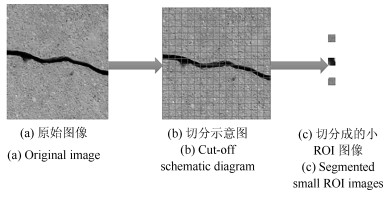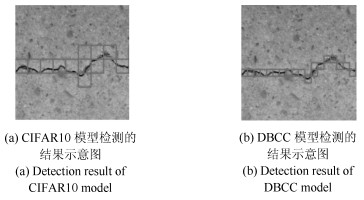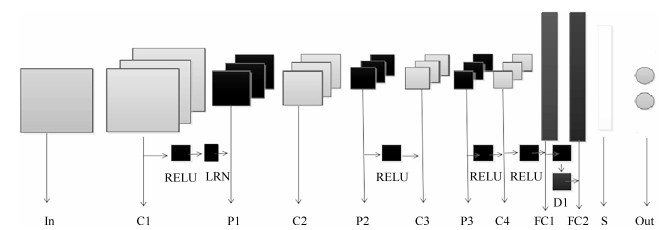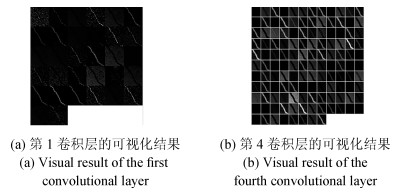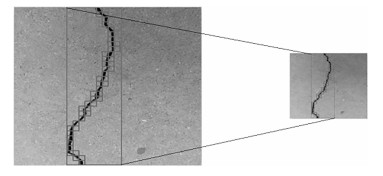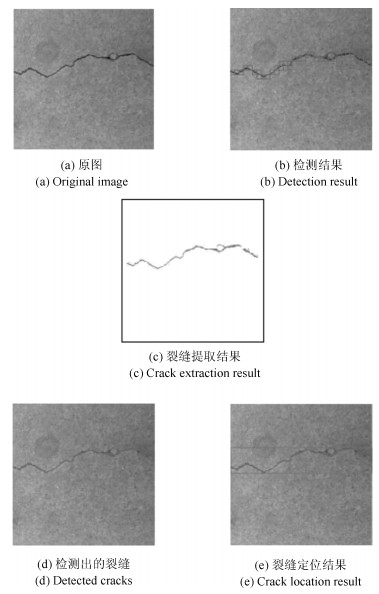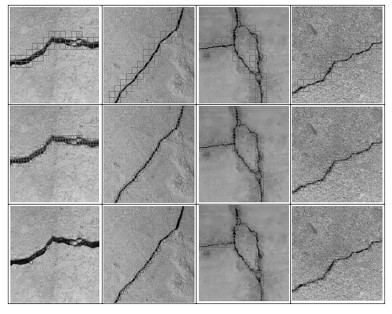-
摘要: 传统的图像处理算法不能很好地对桥梁裂缝进行检测,而经典的深度学习模型直接用于桥梁裂缝的检测,效果不甚理想.针对这些问题,本文提出了一种基于深度学习的桥梁裂缝检测算法.首先,利用滑动窗口算法将桥梁裂缝图像切分为较小的桥梁裂缝面元图像和桥梁背景面元图像,并根据对面元图像的分析,提出一种基于卷积神经网络(Convolutional neural networks,CNN)的DBCC(Deep bridge crack classify)分类模型,用于桥梁背景面元和桥梁裂缝面元的识别.然后,基于DBCC分类模型结合改进的窗口滑动算法对桥梁裂缝进行检测.最后,采用图像金字塔和感兴趣区域(Region of interest,ROI)结合的搜索策略对算法进行加速.实验结果表明:与传统算法相比,本文算法具有更好的识别效果和更强的泛化能力.Abstract: The traditional image processing algorithms failed to detect the bridge cracks and the effect was not ideal if the classical deep learning models were used to detect the bridge cracks directly. In order to solve these problems, an algorithm for the detection of bridge cracks based on deep learning was proposed. Firstly, the bridge images with cracks were divided into smaller bridge crack patches and bridge background patches by using the window sliding algorithm. According to the analysis of the patches, a classification model based on convolutional neural network, called DBCC (Deep bridge crack classify), was proposed and the model was used to identify the bridge background patches and bridge crack patches. Secondly, the DBCC classification model combined with an improved window sliding algorithm was used for the detection of bridge cracks. Finally, the algorithm was accelerated by using a search strategy of combining image pyramid and ROI. The experimental results show that the algorithm has better recognition effect and stronger generalization ability compared with the traditional algorithm.
-
Key words:
- Crack detection /
- deep learning /
- convolutional neural network /
- window sliding algorithm
1) 本文责任编委 王亮 -
表 1 DBCC模型的输入层至第2池化层各层的具体模型构建参数
Table 1 Modeling parameters from the input layer to the second pool layer of the DBCC model
模型 输入层 卷积层1 Max-Pooling 1 卷积层2 Ave-Pooling 2 CIFAR10 32 × 32 × 3 Conv5-1-2-32 MP3-2-0-32 Conv5-1-2-32 AVE3-2-0-32 DBCC-A 16 × 16 × 3 Conv3-1-1-32 MP3-2-0-32 Conv3-1-1-32 AVE3-2-0-32 DBCC-B 16 × 16 × 3 Conv5-1-2-32 MP3-2-0-32 Conv5-1-2-32 AVE3-2-0-32 DBCC-C 16 × 16 × 3 Conv5-1-2-32 MP2-2-0-32 Conv5-1-2-32 AVE2-2-0-32 DBCC-D 16 × 16 × 3 Conv5-1-2-32 MP2-2-0-32 Conv5-1-2-64 AVE2-2-0-64 DBCC-E 16 × 16 × 3 Conv5-1-2-32-LRN MP2-2-0-32 Conv5-1-2-64 AVE2-2-0-64 DBCC 16 × 16 × 3 Conv5-1-2-32-LRN MP2-2-0-32 Conv5-1-2-64 AVE2-2-0-64 表 2 DBCC模型的第3卷积层至输出层各层的具体模型构建参数
Table 2 Modeling parameters from the third volume accumulated layer to the output layer of the DBCC model
模型 卷积层3 Ave-Pooling 3 卷积层4 FC1 Dropout层 FC2 输出层 CIFAR10 Conv5-1-2-64 AVE3-2-0-64 --- 2 --- --- Softmax DBCC-A Conv3-1-1-64 AVE3-2-0-64 --- 2 --- --- Softmax DBCC-B Conv5-1-2-64 AVE3-2-0-64 --- 2 --- --- Softmax DBCC-C Conv5-1-2-64 AVE2-2-0-64 Conv2-1-0-64 2 --- --- Softmax DBCC-D Conv5-1-2-128 AVE2-2-0-128 Conv2-1-0-256 128 --- 2 Softmax DBCC-E Conv5-1-2-128 AVE2-2-0-128 Conv2-1-0-256 128 --- 2 Softmax DBCC Conv5-1-2-128 AVE2-2-0-128 Conv2-1-0-256 128 Dropout 2 Softmax 表 3 人工数据集扩增方法对于DBCC模型识别准确率的影响
Table 3 Effect of artificial data set amplification on recognition accuracy of DBCC model
桥梁裂缝面元的总数 有无数据集的扩增 DBCC模型正确识别数 准确率 500 无 353 70.6 500 有 489 97.8 表 4 各模型对于桥梁裂缝面元识别的准确率
Table 4 Accuracy of each model for bridge crack surface element identification
行号 模型 裂缝面元的总数 裂缝面元规格(像素) 正确识别的裂缝面元数(幅) 识别的准确率(%) 0 CIFAR10 1 000 8×8 34 3.4 1 CIFAR10 1 000 16 × 16 347 34.7 2 CIFAR10 1 000 32 × 32 976 97.6 3 DBCC-A 1 000 16 × 16 954 95.4 4 DBCC-B 1 000 16 × 16 958 95.8 5 DBCC-C 1 000 16 × 16 960 96.0 6 DBCC-D 1 000 16 × 16 970 97.0 7 DBCC-E 1 000 16 × 16 973 97.3 8 DBCC 1 000 8 × 8 48 4.8 9 DBCC 1 000 16 × 16 979 97.9 表 5 算法加速策略对于本文识别算法的影响
Table 5 Effect of algorithm acceleration strategy on the recognition algorithm in this paper
桥梁裂缝图像的编号 未采用加速策略耗时(s) 采用加速策略耗时(s) 1 16.976065 3.345511 2 17.332235 3.324066 3 16.834522 3.295553 4 17.793048 3.500678 5 17.123332 3.349923 表 6 桥梁裂缝定位的位置坐标
Table 6 Position coordinates of bridge crack location
图像的编号 左上角点坐标(像素) 右下角点坐标(像素) 1 (239, 0) (381, 512) 2 (0, 98) (512, 370) 3 (0, 33) (512, 385) 4 (218, 0) (294, 512) 表 7 桥梁裂缝定位准确度的量化分析
Table 7 Quantitative analysis of location accuracy of bridge cracks
表 8 桥梁裂缝检测提取算法的量化分析对比
Table 8 Quantitative analysis and comparison of bridge crack detection and extraction algorithm
算法 迭代阈值分割算法 FFA算法 最小路径选择算法 本文算法 评价指标 Pre/Rec Pre/Rec Pre/Rec Pre/Rec 第1幅图像 15.7 %/16.3 % 89.3 %/91.5 % 90.3 %/91.5 % 97.5 %/98.7 第2幅图像 12.5 %/9.5 % 67.5 %/83.5 % 73.5 %/80.4 % 92.39 %/94.6 第3幅图像 5.6 %/5.57 % 90.5 %/90.3 % 63.3 %/64.39 % 94.5 %/96.3 第4幅图像 7.8 %/7.5 % 18.3 %/21.7 % 35.7 %/20.3 % 91.31 %/92.5 第5幅图像 10.1 %/13.4 % 73.2 %/63.7 % 91.2 %/93.5 % 91.6 %/90.4 平均运行时间(s) 0.936 3.896 11.314 3.357 -
[1] 马建, 孙守增, 杨琦.中国桥梁工程学术研究综述:2014.中国公路学报, 2014, 27(5):1-96 http://d.old.wanfangdata.com.cn/Periodical/zgglxb201405001Ma Jian, Sun Shou-Zeng, Yang Qi. Review on China's bridge engineering research:2014. China Journal of Highway and Transport, 2014, 27(5):1-96 http://d.old.wanfangdata.com.cn/Periodical/zgglxb201405001 [2] 魏武, 王俊杰, 蔡钊雄.基于小波和Radon变换的桥梁裂缝检测.计算机工程与设计, 2013, 34(9):3151-3157 http://d.old.wanfangdata.com.cn/Periodical/jsjgcysj201309031Wei Wu, Wang Jun-Jie, Cai Zhao-Xiong. Bridge crack detection based on wavelet and Radon transform. Computer Engineering and Design, 2013, 34(9):3151-3157 http://d.old.wanfangdata.com.cn/Periodical/jsjgcysj201309031 [3] Oh H, Garrick N W, Achenie L E K. Segmentation algorithm using iterative clipping for processing noisy pavement images. In:Proceedings of the 2nd International Conference on Imaging Technologies:Techniques and Applications in Civil Engineering. Davos, Switzerland:TRID, 1998. 138-147 https://cedb.asce.org/CEDBsearch/record.jsp?dockey=0109703 [4] Li Q Q, Liu X L. Novel approach to pavement image segmentation based on neighboring difference histogram method. In:Proceedings of the 2008 Congress on Image and Signal Processing. Sanya, Hainan, China:IEEE, 2008. 792-796 https://ieeexplore.ieee.org/document/4566413 [5] Landstrom A, Thurley M J. Morphology-based crack detection for steel slabs. IEEE Journal of Selected Topics in Signal Processing, 2012, 6(7):866-875 doi: 10.1109/JSTSP.2012.2212416 [6] Varadharajan S, Jose S, Sharma K, Wander L, Mertz C. Vision for road inspection. In:Proceedings of the 2014 IEEE Winter Conference on Applications of Computer Vision (WACV). Steamboat Springs, CO, USA:IEEE, 2014. 115-122 https://ieeexplore.ieee.org/document/6836111 [7] Jahanshahi M R, Masri S F, Padgett C W, Sukhatme G S. An innovative methodology for detection and quantification of cracks through incorporation of depth perception. Machine Vision and Applications, 2013, 24(2):227-241 http://www.wanfangdata.com.cn/details/detail.do?_type=perio&id=c9ba111ad8b36c3b26d43287663c1fdb [8] Amhaz R, Chambon S, Idier J, Baltazart V. Automatic crack detection on two-dimensional pavement images:an algorithm based on minimal path selection. IEEE Transactions on Intelligent Transportation Systems, 2016, 17(10):2718-2729 doi: 10.1109/TITS.2015.2477675 [9] Zou Q, Cao Y, Li Q Q, Mao Q Z, Wang S. CrackTree:automatic crack detection from pavement images. Pattern Recognition Letters, 2012, 33(3):227-238 http://d.old.wanfangdata.com.cn/NSTLQK/NSTL_QKJJ0226254615/ [10] Oliveira H, Correia P L. Automatic road crack detection and characterization. IEEE Transactions on Intelligent Transportation Systems, 2013, 14(1):155-168 http://d.old.wanfangdata.com.cn/Periodical/jsjfzsjytxxxb201409008 [11] Nguyen T S, Begot S, Duculty F, Avila M. Free-form anisotropy:a new method for crack detection on pavement surface images. In:Proceedings of the 18th IEEE International Conference on Image Processing (ICIP). Brussels, Belgium:IEEE, 2011. 1069-1072 https://ieeexplore.ieee.org/document/6115610 [12] Mustafa R, Mohamed E A. Concrete crack detection based multi-block CLBP features and SVM classifier. Journal of Theoretical and Applied Information Technology, 2015, 81(1):151-160 [13] Nguyen H N, Kam T Y, Cheng P Y. An automatic approach for accurate edge detection of concrete crack utilizing 2D geometric features of crack. Journal of Signal Processing Systems, 2014, 77(3):221-240 doi: 10.1007/s11265-013-0813-8 [14] Arena A, Piane C D, Sarout J. A new computational approach to cracks quantification from 2D image analysis:application to micro-cracks description in rocks. Computers & Geosciences, 2014, 66:106-120 https://www.sciencedirect.com/science/article/pii/S0098300414000107 [15] Quintana M, Torres J, Menéndez J M. A simplified computer vision system for road surface inspection and maintenance. IEEE Transactions on Intelligent Transportation Systems, 2016, 17(3):608-619 http://www.wanfangdata.com.cn/details/detail.do?_type=perio&id=e6dd7d675797cd3abc3bdd685ed72d27 [16] Shi Y, Cui L M, Qi Z Q, Meng F, Chen Z S. Automatic road crack detection using random structured forests. IEEE Transactions on Intelligent Transportation Systems, 2016, 17(12):3434-3445 doi: 10.1109/TITS.2016.2552248 [17] Zhang D J, Li Q Q, Chen Y, Cao M, He L, Zhang B L. An efficient and reliable coarse-to-fine approach for asphalt pavement crack detection. Image and Vision Computing, 2017, 57:130-146 doi: 10.1016/j.imavis.2016.11.018 [18] Hassan N, Mathavan S, Kamal K. Road crack detection using the particle filter. In:Proceedings of the 23rd International Conference on Automation and Computing. Huddersfield, UK:IEEE, 2017. 1-6 [19] Oliveira H, Correia P L. Road surface crack detection:Improved segmentation with pixel-based refinement. In:Proceedings of the 25th European Signal Processing Conference. Kos, Greece:IEEE, 2017. 2026-2030 https://ieeexplore.ieee.org/document/8081565/ [20] Simonyan K, Zisserman A. Two-stream convolutional networks for action recognition in videos. In:Proceedings of the 27th International Conference on Neural Information Processing Systems. Montreal, Canada:MIT Press, 2014. 568-576 http://www.oalib.com/paper/4082156 [21] Zeiler M D, Fergus R. Visualizing and understanding convolutional networks. In:Proceedings of the 13th European Conference on Computer Vision. Zurich, Switzerland:Springer, 2014. 818-833 doi: 10.1007%2F978-3-319-10590-1_53 [22] Krizhevsky A, Sutskever I, Hinton G E. ImageNet classification with deep convolutional neural networks. In:Proceedings of the 25th International Conference on Neural Information Processing Systems. Lake Tahoe, Nevada:Curran Associates Inc., 2012. 1097-1105 https://dl.acm.org/citation.cfm?id=2999257 [23] Szegedy C, Liu W, Jia Y Q, Sermanet P, Reed S, Anguelov D, et al. Going deeper with convolutions. In:Proceedings of the 2015 IEEE Conference on Computer Vision and Pattern Recognition (CVPR). Boston, MA, USA:IEEE, 2015. 1-9 http://www.oalib.com/paper/4068635#.XY1zPvngmMs [24] Szegedy C, Vanhoucke V, Ioffe S, Shlens J, Wojna Z. Rethinking the inception architecture for computer vision. In:Proceedings of the 2016 IEEE Conference on Computer Vision and Pattern Recognition (CVPR). Las Vegas, NV, USA:IEEE, 2016. 2818-2826 https://arxiv.org/abs/1512.00567v2 [25] Girshick R. Fast R-CNN. In:Proceedings of the 2015 IEEE International Conference on Computer Vision (ICCV). Santiago, Chile:IEEE, 2015. 1440-1448 https://ieeexplore.ieee.org/document/7410526?arnumber=7410526 [26] Ren S Q, He K M, Girshick R, Sun J. Faster R-CNN:towards real-time object detection with region proposal networks. IEEE Transactions on Pattern Analysis and Machine Intelligence, 2017, 39(6):1137-1149 doi: 10.1109/TPAMI.2016.2577031 [27] Krizhevsky A. Convolutional deep belief networks on cifar-10[Online], available: http://www.cs.toronto.edu//kriz//conv-cifar10-aug2010.pdf, Aygyst 1, 2010 [28] Lin M, Chen Q, Yan S C. Network in network. arXiv PreprintarXiv: 1312.4400, 2014 http://www.oalib.com/paper/4042246#.XY1zuPngmMs [29] Hinton G E, Srivastava N, Krizhevsky A, Sutskever I, Salakhutdinov R R. Improving neural networks by preventing co-adaptation of feature detectors. arXiv Preprint, arXiv: 1207.0580, 2012 -





 下载:
下载:
